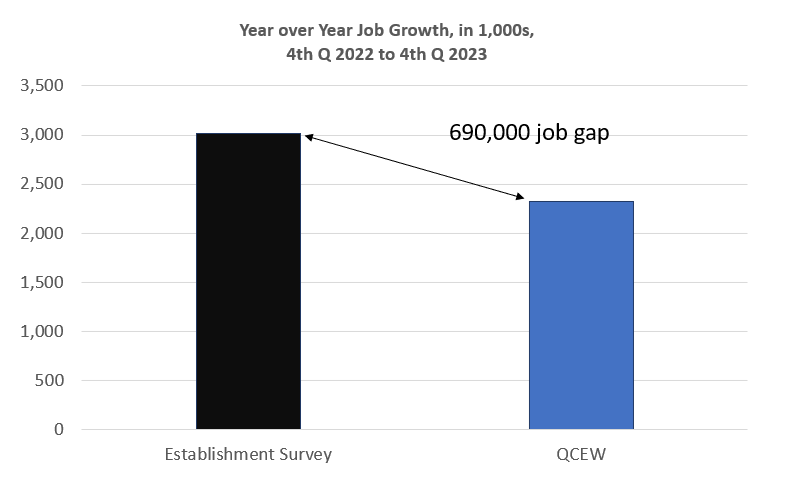More than half a trillion dollars in losses. A trillion is a thousand billion. The latest from the nation’s deposit insurer, the FDIC, is “Unrealized losses on available-for-sale and held-to-maturity securities increased by $39 billion to $517 billion in the first quarter.”
The Federal Reserve’s higher for longer policy is making bank balance sheets weaker and weaker.
Bond values decrease when interest rates increase. Thus, “Higher unrealized losses on residential mortgage-backed securities, resulting from higher mortgage rates in the first quarter, drove the overall increase. This is the ninth straight quarter of unusually high unrealized losses since the Federal Reserve began to raise interest rates in the first quarter of 2022.“
The number of banks on the problem list rose in this year’s 1st quarter from 52 in Q4 to 63 representing 1.4 percent of total banks, which, according to the FDIC “was within the normal range for non-crisis periods of one to two percent of all banks.” Readers should know this is very much a lagging indicator. It takes an FDIC examination to downgrade a bank and these examinations happen every year or two. There are plenty of sick banks which haven’t been examined yet.
One bank examiners haven’t checked in on is Axos Financial. Hindenburg Research has published a blistering report that sent Axos shares tumbling on June 4th, while the same day, the stock was rated a strong buy by Zacks.
In Hindenburg’s opening summary this jumped out: “Our research, including industry analysis, interviews with 21 former employees, lease agents and industry experts, combined with an examination of Axos’ loan book derived through local property records, indicates a company exposed to the riskiest asset classes with lax underwriting standards and a loan book filled with multiple glaring problems.”
Axos is a $20 billion bank which has been lending aggressively on real estate located in New York City and California. For instance, the bank loaned on former President Trump’s flagship New York tower.
The Axos M.O. has been to lend to those who couldn’t get financed anywhere else. One ex-Axos employee told Hindenburg, “If the felony was explainable, we’ll bank them”. Another said bad “credit scores…didn’t kill a deal”. A third couldn’t “recall there ever really being a…minimum net worth or minimum liquidity requirement.”
While other banks passed on loans in the deteriorating commercial real estate market post-covid pandemic, Axos doubled down, nearly doubling its exposure from $5.5 billion in March 2021 to $9.9 billion in March 2024. Now, over half of Axos’ total loan book is exposed to these segments.
The Hindenburg report provides many individual examples of sketchy loans made by Axos to sketchy characters. Not atypical is one where Axos lent up to $97.5 million for an apartment construction project in Queens where the “borrower has been criminally indicted twice personally, including a case involving a construction kickback scheme with a mafia captain. His company was indicted in a third case.”
Then there’s this one. In 2021, Axos made a $34.7 million construction loan for a medical office building in Harlem at 2226 Third Avenue. Two years later “the borrower faced multiple foreclosures after allegations emerged that he had embezzled money from real estate projects and lost much of it to extravagant personal spending and gambling on stocks. The borrower is now under investigation by the DoJ and SEC over allegations of embezzling real estate funds, per local media.”
You might presume Axos has a growing non-performing loan ratio. No. That metric has stayed flat. An ex-Axos credit review officer provides the reason, telling Hindenburg that it was common practice to provide “loans to non-performing or doubtful borrowers to avoid recognizing problems.” Similar schemes, also known as “extend and pretend,” were described by former employees during Hindenburg’s investigation.
Axos’ day of reckoning is on the horizon. Hindenburg estimates that “at least $1.1 billion of CRE loans originated at lower interest rates will face renewal in the coming year, testing the sufficiency of Axos’ abnormally low provisions.”
“This business is run on herd mentality,” Nicole Schmidt, a managing partner at investment bank Oberon Securities, told Bloomberg. So when “information comes out, there’s a knee-jerk reaction to sell the whole category. It’s the cockroach theory: “If there’s one cockroach, there’s thousands.”
Yes Ms. Schmidt, there may be thousands, for sure, hundreds.
 Full story here
Are you the author?
Previous post
See more for
Next post
Full story here
Are you the author?
Previous post
See more for
Next post
Tags: Featured,newsletter


























